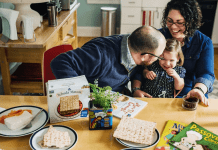My husband and I have walked into my late mother-in-law’s house for the last time.
We are in the process of settling her estate, including the sale of her house and disposition of everything in it.
From a hutch filled with china and crystal goblets to overflowing jewelry boxes and coin collections. And everything in between.
A lot in between.
Her clothes. The Notre Dame sweaters my late father-in-law was so fond of wearing. Her furniture. Furniture inherited from her mother-in-law, still in the same place in the garage where it was originally placed 30 some-odd years ago. My husband’s Cub Scout uniform. Christmas decorations. Lots and lots of Christmas decorations.
Every room, every closet, every shelf, every drawer. Full of stuff. A lifetime of stuff. Two lifetimes, if you count my father-in-law, who passed away 11 years ago.
What to Do With a Lifetime of Stuff
My mother-in-law was a neat and tidy housekeeper. But like many of us (myself included), she lived in a good-sized house with plenty of room to accommodate stuff. Things inherited from her parents and her in-laws. The broken vacuum cleaner waiting for repair in the back of the closet. Hundreds of books read once. You get the picture.
And the cost of disposing of all of that stuff? Having the estate sale company we hired go through every room, every closet, every drawer, separating the trash from the treasures, may cost more than will be generated at the eventual estate sale.
Her house has been transformed into a store, the estate sale company having cleverly arranged and displayed my mother-in-law’s possessions on tables in every room.
All of her possessions with any value, save the very few we kept, each with a tiny white price tag.
Losing your last surviving parent is hard enough. But being the arbiter of which of your parents’ and grandparents’ treasures get saved and which end up sold, donated, or in a landfill? gut-wrenching.
The lesson we have learned from this experience?
Most of the stuff in your house is worthless. And eventually, someone, either you or your kids, will be tasked with the overwhelming job of getting rid of it.
Most of Your Stuff Is Worthless
Most of the stuff in your house is worthless.
Yes, even the stuff you worry the most about, the stuff you think is so good you don’t use it for fear of breaking it, has little to no resale value.
From china, china cabinets, crystal goblets, silver tea sets, pianos, and collectible figurines like Hummels, to grandfather clocks and real pieces of craftsmanship furniture.
Why? Baby boomers have glutted the market with their castoffs, and millennials, the next generation of buyers, don’t want it.
Millennials hate both formal in-home entertaining and use of second-hand goods. With looming student loans, they tend to rent and move often. Who wants to be constantly moving a piano and a grandfather clock from apartment to apartment?
And furniture? There’s no market for so-called “brown furniture,” meaning any furniture (regardless of quality) other than the “mid-century casual” furniture (think clean, lightweight) favored by millennials. Brown furniture is basically firewood.
If it’s not in great condition, it’s also not fit for donation because it can’t be resold.
All of my mother-in-law’s furniture (including the pieces inherited from her mother-in-law and kept for decades)? Straight to the landfill.
Well, Almost Everything…
What do guns, LPs (records), and precious metals/gems have in common?
They are 3 things you might have in your house with a robust resale value.
Silverware also has value, but only if it is real silver and can be melted down.
3 Things You Should Be Doing NOW to Reduce the Amount of Stuff You Have
1. Be viciously thoughtful about holding onto sentimental items.
Here was our goal with sorting through my mother-in-law’s things. Keep just enough to remind us of her, but not so much stuff that our daughters are going to be dealing with it 40 some-odd years from now.
Here’s what we kept:
- A painting to be displayed in our dining room
- My mother-in-law’s treasured Swarovski crystal animal collection (all of which were given to her by her children and grandchildren over the years)
- Jewelry to be divided among the granddaughters
- Each of our daughters got to select 1 item
And that was it.
Well, almost. We did set aside photos to be digitized (with the originals then destroyed).
Was it hard leaving everything else? You bet it was. But we don’t want to be dealing with a lot of stuff years from now (or worse, leaving it to our daughters to deal with).
I try to be viciously thoughtful with my own sentimental items. For example, I don’t save any school papers or art projects from my kids (though I do take photos of my favorites).
2. Buy fewer books.
While used book resellers like Half Price Books do an important service in keeping books in circulation, a surprising number of books end up in landfills because many paper recycling facilities can’t process the the glue that binds book spines.
My resolution last year was to cut down on my book consumption by only reading books that I borrow from the library or purchase on my Kindle e-reader. If you haven’t used a library in years, now is the time to go back. My local library has an app where you can “order” books online, and pick them up the next day on a special “hold” shelf strategically placed next to the check-out kiosk.
How successful was I on my resolution? I read 1 to 2 books a week in 2019, only 1 of which was a hard copy purchased from Amazon.
3. Buy fewer, but better quality, clothes
The world is overflowing with used clothing.
We buy substantially more clothing over our lifetimes than our grandparents did.
Clothing made today is meant to last no more than a few years. In fact, a lot of clothing isn’t even made to withstand more than a few washes.
Think you are “paying it forward” but dropping off a load of unwanted clothes at Goodwill? Think again. Most clothing donations never make it to the racks at Goodwill and only about a third of what does eventually sells.
To really pay it forward, cut down on the amount of clothing you have by buying better quality clothes that last longer.
Keeping What Really Matters
My 5-year-old chose to keep a Christmas music box from her Grandma’s house. It plays “White Christmas” and has tiny ice skaters going around a rink inside. Each Christmas, my mother-in-law would bring out this music box and let each of her granddaughter’s play with it. It’s value in preserving a precious memory of Grandma? Priceless.














I do estate sales on a regular basis, as I am a Seniors Real Estate Specialist- My clients are thrilled to have me handle the liquidations and I typically make enough for them to pay for final removal of remaining items to worthy causes, like Veterans In Transition, rather than Goodwill, which is a “for profit” company. Taking that job off the families hands solves so many issues. Although I agree, nobody wants your Hummels, there is a good market for china and glass, as many artists use them for repurposed yard art. I am a full service Seniors Realtor and can help more than this article indicates. Nancy Philbrick, Berkshire Hathaway Verani, New Hampshire
It’s not about selling off family heirlooms or freeing up space , it’s more about family history and heritage . I’ve kept everything . I’ve got love letters from the first world war and and a bayonet made my Wilkinson sword which was my grandads . He died in 1955 just before I was born . I have all my dad’s army records from world war 2 and boxes of memorabilia from that time . I cannot , would not and will not destroy them or throw them away . It will stay intact for as long as I’m alive in respect of my ancestors . You can’t reminisce in an empty room and the memories of their passing will live long after they’re gone. I hope the same applies to me .
that’s part of the point….the beautiful antiques, quilts, various items may not be wanted by the children or grandchildren at this time in their lives and the family heirlooms sell for a fraction of their worth. Therefore the family doesn’t even get a monetary benefit.
I also truly believe that the same adult children and grandchildren many times wish they had a particular item, or familial information when they are in their 50’s and 60’s, but the material things and / or the photos or family stories are gone.
I have been getting things out of the house for the last 3 years.
My husband and I are also asking the adult “children” what items they may want. I have even encouraged my husband (blended family) to actually give items to the designated family member now for them to enjoy if he chooses.
Digitilizing family photos, slides and tapes for interested family members is also one of my current projects (also to be shared now). Particularly favorite family recipes.
The idea of someone loading up the things I have treasured taking them to a landfill breaks my heart. But of course, you “can’t take it with you”. and Yes, I am a Baby Boomer.:)
Well, yes, but the cost of putting on that sale means that the “worthless” brown furniture *costs* the inheritor/seller. So from her point of view, it was pretty worthless. PLUS, while dealing with grief and loss, she has to deal with this incredibly difficult and time-consuming–and costly–effort to organize and sell this stuff. Sometimes at distance from her home. When my mother-in-law died she left behind so much stuff that after hiring someone who worked–not quite full-time–for weeks, and calling in every friend and relative to volunteer time to help us with the sale–the leftover stuff helped fill 2 rented storage closets, and we already had 2 of our own, because my spouse inherited some of those tendencies along with more junk. She died last spring, about 17 years later, and I’m still paying over $200 per month for the remaining storage closet (the size of a large garage) and I’m still emptying out our house, not sure when I can get to the storage closet to empty that. And this is hard to do. I open a box, thinking I can quickly sort out the stuff even I can’t throw away or donate, and find sometimes that 3 hours later I’m just weeping and can’t throw most of it out, anyhow. So when you buy that brown furniture, I hope it’s stuff you really can use, and not going into the garage corner for when you have time to refinish it, or properly shampoo it, or . . . .
This is a sad, even disturbing story. There are possibly millions of people who WANT the vintage and antique items described in this story. If the author didn’t make a small fortune with this estate sale, they were ROBBED by the company that held the sale.
I do agree with you, Candace. I inherited a lot of “treasures” from my parents when they passed away, and I have kept many of them because they have stories attached to them or I remember them from my youth. My daughter has already claimed some of them, partly because of those stories, or because they represent our German and Danish heritages. We have a local consignment shop that accepts high quality furniture, glassware, lamps, etc. and many people frequent it because you can buy a solid wood, beautiful dresser for the same price as a cheap pine one from Ikea that will fall apart in a few years.
This made me so sad. But I also can totally understand where you are coming from. I am in my middle thirties and I LOVE china and glassware. Most of what I have was given to me. I make a strict point to only acquire a certain select types but I don’t use most of it. :/ I just put in my china hutch that was given to me by a dear friend who is in her 70s and could not take it with her when she moved. I have had to move it once and it was the most difficult part of my move – meaning the heaviest and hardest to place in my tiny kitchen so that is what I mean when I said I understand. I think the worst part of this is the destroy of the old photos after being digitized! I would think sitting around a box or album of old photos would be more meaningful than looking at them on a screen.
I was at a conference on sustainability and Goodwill had a presentation. They take all fabrics, all clothing wearable or not, saleable or not. What they don’t think will sell, they sell to companies that can use the fabric to make other things. They also ship overseas to countries that are fiber poor, such as many in Africa, to make shingles and other products.
Siobhan is Joan in English. In Ireland I had a girlfriend with that name.
In reference to your comments on clothes. I donate some clothing to the local Civic Theater to use for costumes. The ones they cannot use as complete, they repurpose the cloth.
Really great article. I’ve seen it before and it is worth rereading every year.
I, too, spent 5 years as a seniors estate liquidator. Accidentally fell into it and through word of mouth became quite busy and fairly good at it. Mostly eBay activity and sometimes earning $1000s for my clients ($100s for myself). I had to stop though. Telling nice “Mr. Wilson” that no one wanted his antique broken toy train was very difficult as “Mr. Wilson” was incredulous (and angry) that no one wanted it. “Mrs. Jones” always wanted me to get more money for her things… If the vintage doll (missing her head) sold on eBay for $50 she would refuse to honor the deal unless the buyer coughed up another $15 after the auction was over… eBay doesn’t work that way I would explain for the 3rd time. At times I felt like a hero and at times I felt like a thief… people are very sentimental about their things..and they ALL think that their stuff is worth way more than it is… my happiest clients were the children of the collectors. They had been tasked with clearing Mom’s house after her passing… they didn’t want the stuff, didn’t need the money and just didn’t want to be the one to get rid of it. I was able to advise them, point out the truly valuable and possibly worth keeping (in terms of $) items and turn the rest into cash for them.
I can be really “wordy”, but this will be short. Yes, I am a baby boomer and brought up with a different set of values than the young people today. First, about the “brown furniture” please check Southern Living. The “brown furniture” is back! It lasts forever. Yep, get rid of that old, ugly clock! One of my Dad’s auctioned for $32,000! You can shop at Ikea for the plastic things and eat off paper plates. I choose to eat off china or glass plates. Angry, yes, but you do your thing and I will auction some more “brown furniture” to those who value quality and not plastic from Ikea!